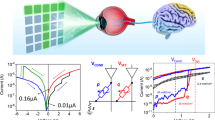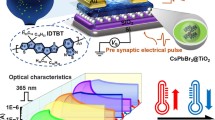Abstract
The neural network image sensor—which mimics neurobiological functions of the human retina—has recently been demonstrated to simultaneously sense and process optical images. However, highly tunable responsivity concurrent with non-volatile storage of image data in the neural network would allow a transformative leap in compactness and function of these artificial neural networks. Here, we demonstrate a reconfigurable and non-volatile neuromorphic device based on two-dimensional semiconducting metal sulfides that is concurrently a photovoltaic detector. The device is based on a metal–semiconductor–metal (MSM) two-terminal structure with pulse-tunable sulfur vacancies at the M–S junctions. By modulating sulfur vacancy concentrations, the polarities of short-circuit photocurrent can be changed with multiple stable magnitudes. The bias-induced motion of sulfur vacancies leads to highly reconfigurable responsivities by dynamically modulating the Schottky barriers. A convolutional neuromorphic network is finally designed for image processing and object detection using the same device. The results demonstrated that neuromorphic photodetectors can be the key components of visual perception hardware.




Similar content being viewed by others
Data availability
The data that support the conclusions of this study are available from the corresponding authors upon reasonable request. Source data are provided with this paper.
Code availability
The codes used for simulation and data plotting are available from the corresponding authors upon reasonable request.
References
Sze, V., Chen, Y.-H., Emer, J., Suleiman, A. & Zhang, Z. Hardware for machine learning: challenges and opportunities. In 2017 IEEE Custom Integrated Circuits Conference (CICC) 179–186 (IEEE, 2017).
Zhou, F. C. & Chai, Y. Near-sensor and in-sensor computing. Nat. Electron. 3, 664–671 (2020).
Gollisch, T. & Meister, M. Even smarter than scientists believed: neural computations in circuits of the retina. Neuron 65, 150–164 (2010).
Kyuma, K. et al. Artificial retinas—fast, versatile image processors. Nature 372, 197–198 (1994).
Kolb, H. How the retina works—much of the construction of an image takes place in the retina itself through the use of specialized neural circuits. Am. Scientist 91, 28–35 (2003).
Funatsu, E. et al. An artificial retina chip with current-mode focal plane image processing functions. IEEE Trans. Electron Devices 44, 1777–1782 (1997).
Nitta, Y., Ohta, J., Tai, S. & Kyuma, K. Variable-sensitivity photodetector that uses a metal-semiconductor-metal structure for optical neural networks. Opt. Lett. 16, 611–613 (1991).
Jang, H. et al. In-sensor optoelectronic computing using electrostatically doped silicon. Nat. Electron. 5, 519–525 (2022).
Mennel, L. et al. Ultrafast machine vision with 2D material neural network image sensors. Nature 579, 62–66 (2020).
Chen, S., Lou, Z., Chen, D. & Shen, G. Z. An artificial flexible visual memory system based on an UV-motivated memristor. Adv. Mater. 30, 1705400 (2018).
Cui, B. Y. et al. Ferroelectric photosensor network: an advanced hardware solution to real-time machine vision. Nat. Commun. 13, 1707 (2022).
Sun, L. F. et al. In-sensor reservoir computing for language learning via two-dimensional memristors. Sci. Adv. 7, eabg1455 (2021).
Zhou, F. C. et al. Optoelectronic resistive random access memory for neuromorphic vision sensors. Nat. Nanotechnol. 14, 776–782 (2019).
Ahmed, T. et al. Optically stimulated artificial synapse based on layered black phosphorus. Small 15, 1900966 (2019).
Fu, X. et al. Graphene/MoS2−xOx/graphene photomemristor with tunable non-volatile responsivities for neuromorphic vision processing. Light.: Sci. Appl. 12, 39 (2023).
Lee, S. H., Peng, R. M., Wu, C. M. & Li, M. Programmable black phosphorus image sensor for broadband optoelectronic edge computing. Nat. Commun. 13, 1485 (2022).
Liao, F. Y. et al. Bioinspired in-sensor visual adaptation for accurate perception. Nat. Electron. 5, 84–91 (2022).
Liu, K. Q. et al. An optoelectronic synapse based on α-In2Se3 with controllable temporal dynamics for multimode and multiscale reservoir computing. Nat. Electron. 5, 761–773 (2022).
Pi, L. J. et al. Broadband convolutional processing using band-alignment-tunable heterostructures. Nat. Electron. 5, 248–254 (2022).
Seo, S. H. et al. Artificial optic-neural synapse for colored and color-mixed pattern recognition. Nat. Commun. 9, 5106 (2018).
Wang, C.-Y. et al. Gate-tunable van der Waals heterostructure for reconfigurable neural network vision sensor. Sci. Adv. 6, eaba6173 (2020).
Yu, J. R. et al. Bioinspired mechano-photonic artificial synapse based on graphene/MoS2 heterostructure. Sci. Adv. 7, eabd9117 (2021).
Zhang, Z. H. et al. All-in-one two-dimensional retinomorphic hardware device for motion detection and recognition. Nat. Nanotechnol. 17, 27–32 (2022).
Lien, D.-H. et al. Engineering light outcoupling in 2D materials. Nano Lett. 15, 1356–1361 (2015).
Wang, Q. H., Kalantar-Zadeh, K., Kis, A., Coleman, J. N. & Strano, M. S. Electronics and optoelectronics of two-dimensional transition metal dichalcogenides. Nat. Nanotechnol. 7, 699–712 (2012).
Shim, J. et al. Controlled crack propagation for atomic precision handling of wafer-scale two-dimensional materials. Science 362, 665–670 (2018).
Khan, M. A. et al. The non-volatile electrostatic do** effect in MoTe2 field-effect transistors controlled by hexagonal boron nitride and a metal gate. Sci. Rep. 12, 12085 (2022).
Wang, M. et al. Robust memristors based on layered two-dimensional materials. Nat. Electron. 1, 130–136 (2018).
Zhu, X. J., Li, D., Liang, X. & Lu, W. D. Ionic modulation and ionic coupling effects in MoS2 devices for neuromorphic computing. Nat. Mater. 18, 141–148 (2019).
Lee, H. S. et al. MoS2 nanosheets for top‐gate nonvolatile memory transistor channel. Small 8, 3111–3115 (2012).
Chen, H. W. et al. Logic gates based on neuristors made from two-dimensional materials. Nat. Electron. 4, 399–404 (2021).
Liu, W. et al. Graphene charge-injection photodetectors. Nat. Electron. 5, 281–288 (2022).
Tong, L. et al. 2D materials-based homogeneous transistor-memory architecture for neuromorphic hardware. Science 373, 1353–1358 (2021).
Wang, Y. et al. An in-memory computing architecture based on two-dimensional semiconductors for multiply-accumulate operations. Nat. Commun. 12, 3347 (2021).
Miao, J. S. et al. Heterojunction tunnel triodes based on two-dimensional metal selenide and three-dimensional silicon. Nat. Electron. 5, 744–751 (2022).
Choi, C. S. et al. Human eye-inspired soft optoelectronic device using high-density MoS2-graphene curved image sensor array. Nat. Commun. 8, 1664 (2017).
Cao, R. R. et al. Compact artificial neuron based on anti-ferroelectric transistor. Nat. Commun. 13, 7018 (2022).
Kim, S. H. et al. Effects of plasma treatment on surface properties of ultrathin layered MoS2. 2D Mater. 3, 035002 (2016).
Kang, N., Paudel, H. P., Leuenberger, M. N., Tetard, L. & Khondaker, S. I. Photoluminescence quenching in single-layer MoS2 via oxygen plasma treatment. J. Phys. Chem. C 118, 21258–21263 (2014).
Duy, L., Rawal, T. B. & Rahman, T. S. Single-layer MoS2 with sulfur vacancies: structure and catalytic application. J. Phys. Chem. C 118, 5346–5351 (2014).
Komsa, H.-P., Kurasch, S., Lehtinen, O., Kaiser, U. & Krasheninnikov, A. V. From point to extended defects in two-dimensional MoS2: evolution of atomic structure under electron irradiation. Phys. Rev. B 88, 035301 (2013).
Li, D. et al. MoS2 memristors exhibiting variable switching characteristics toward biorealistic synaptic emulation. ACS Nano 12, 9240–9252 (2018).
Sangwan, V. K. et al. Multi-terminal memtransistors from polycrystalline monolayer molybdenum disulfide. Nature 554, 500–504 (2018).
Chen, Q. et al. Ultralong 1D vacancy channels for rapid atomic migration during 2D void formation in monolayer MoS2. ACS Nano 12, 7721–7730 (2018).
Zhou, X. Y., Koltun, V. & Krähenbühl, P. Tracking objects as points. In 16th European Conference on Computer Vision (ECCV) 474–490 (Springer, 2020).
Redmon, J., Divvala, S., Girshick, R. & Farhadi, A. You only look once: unified, real-time object detection. In 2016 IEEE Conference on Computer Vision and Pattern Recognition (CVPR) 779–788 (IEEE, 2016).
Ren, S., He, K., Girshick, R. & Sun, J. Faster R-CNN: towards real-time object detection with region proposal networks. IEEE Trans. Pattern Anal. Mach. Intell. 39, 1137–1149 (2017).
Ielmini, D. & Wong, H. S. P. In-memory computing with resistive switching devices. Nat. Electron. 1, 333–343 (2018).
Acknowledgements
This work was supported by the National Key Research and Development Program of China (grant no. 2021YFA0715602), the National Natural Science Foundation of China (grant nos. 62261136552, 62005303 and 62134001), the International Partnership Program of Chinese Academy of Sciences (grant no. 181331KYSB20200012), the Science and Technology Commission of Shanghai Municipality (grant no. 21JC1406100), the Alfred P. Sloan Foundation (Sloan Fellowship in Chemistry) (D.J.) and the Open Research Projects of Zhejiang Laboratory (grant no. 2022NK0AB01). We thank X. Zhang and L. Ma from the Core Facility of Wuhan University for their assistance with WDS measurement.
Author information
Authors and Affiliations
Contributions
J.M., D.J. and W.H. conceived the idea and directed the collaboration and execution. T.L. and X.F. fabricated the devices and performed the measurements. T.L., J.M., P.Z., X.W., D.J. and W.H. analysed the experimental data. T.L., X.Z. and J.M. did the TCAD device simulation. X.Z. and X.G. did the first-principles theory. B.S. and B.C. performed the Artificial Intelligence object detection. T.L., J.M., W.H. and D.J. cowrote the manuscript with contributions from all the authors. All authors discussed the results and implications and commented on the manuscript at all stages.
Corresponding authors
Ethics declarations
Competing interests
The authors declare no competing interests.
Peer review
Peer review information
Nature Nanotechnology thanks Lincoln Lauhon and Yu-Jung Lu for their contribution to the peer review of this work.
Additional information
Publisher’s note Springer Nature remains neutral with regard to jurisdictional claims in published maps and institutional affiliations.
Supplementary information
Supplementary Information
Supplementary Figs. 1–32 and Tables 1–3.
Source data
Source Data Fig. 1
Device characterizations of the plasma-treated MoS2 MSM photovoltaic detectors.
Source Data Fig. 2
Photocurrent map** and pulse programmable characteristics of plasma-treated and pristine MoS2 MSM devices.
Source Data Fig. 3
Sulfur vacancies migration and potential profile in the plasma-treated MoS2 MSM devices.
Source Data Fig. 4
Object detection using MoS2 MSM devices with reconfigurable and non-volatile responsivities.
Rights and permissions
Springer Nature or its licensor (e.g. a society or other partner) holds exclusive rights to this article under a publishing agreement with the author(s) or other rightsholder(s); author self-archiving of the accepted manuscript version of this article is solely governed by the terms of such publishing agreement and applicable law.
About this article
Cite this article
Li, T., Miao, J., Fu, X. et al. Reconfigurable, non-volatile neuromorphic photovoltaics. Nat. Nanotechnol. 18, 1303–1310 (2023). https://doi.org/10.1038/s41565-023-01446-8
Received:
Accepted:
Published:
Issue Date:
DOI: https://doi.org/10.1038/s41565-023-01446-8
- Springer Nature Limited
This article is cited by
-
Nonvolatile and reconfigurable two-terminal electro-optic duplex memristor based on III-nitride semiconductors
Light: Science & Applications (2024)
-
Reconfigurable memlogic long wave infrared sensing with superconductors
Light: Science & Applications (2024)
-
General synthesis of ionic-electronic coupled two-dimensional materials
Nature Communications (2024)
-
Two-dimensional materials for future information technology: status and prospects
Science China Information Sciences (2024)
-
Reconfigurable WSe2 Schottky heterojunctions for logic rectifiers and ultrafast photodetectors
Science China Materials (2023)





